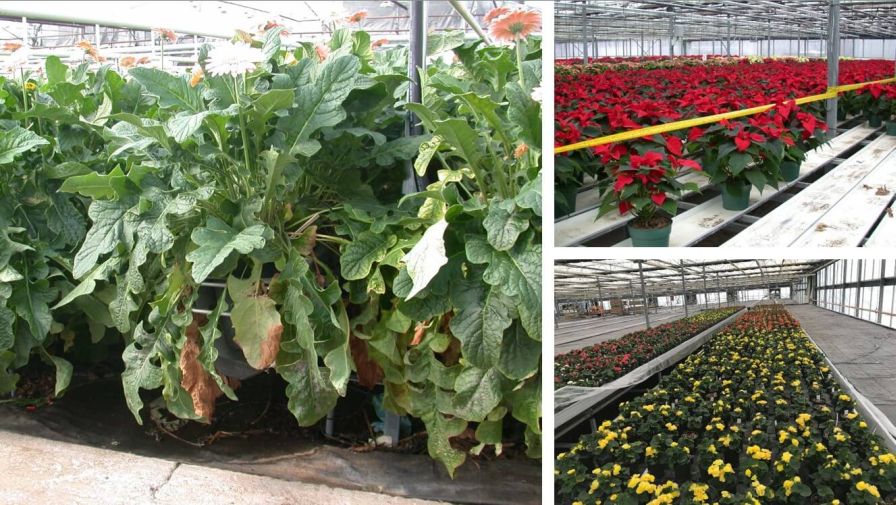The Potential Role of Air-Assisted Spraying in the Greenhouse

Crop canopy morphology and planting architecture are highly variable from operation to operation. Photo: Sprayers101.com
The aesthetic value of ornamental plants requires a near-zero tolerance for insect pests, which cause up to 10% of crop losses per season. Controlling them with insecticides, however, is a difficult proposition.
Key pests such as thrips, aphids, and whiteflies tend to feed on the underside of leaves – a notoriously difficult surface to target because of its orientation relative to the spray nozzle. Other pests, such as mealybugs, are found on stems. Stems are hard-to-wet plant surfaces because spray tends to run off. Further, as the plant canopy grows and densifies, these surfaces are buried deep inside, out of the line of sight.
Finally, the insecticides available for closed environment spraying must be compatible with biological controls and are, therefore softer chemistries. Examples include soaps, oils, and entomopathogenic fungi. These products require contact with the pest and are at best translaminar, so coverage becomes critical for performance.
The planting architectures and canopy morphologies are highly variable in ornamental greenhouses. Perhaps they are young plants with sparse canopies, densely packed in pots on raised tables. Perhaps they are mature, hanging plants with dense canopies. Perhaps they are something in between.
Crop canopy morphology and planting architecture are highly variable from operation to operation. Ideally, each combination of canopy morphology, planting architecture, pest, and chemistry would have a specific sprayer designed to optimize coverage and efficiency. This is economically unrealistic. Instead, many producers utilize technologies that rely on high water volumes and hydraulic pressures to drench targets indiscriminately. Others employ highly manual methods that allow the operator to aim the nozzle in relation to the canopy on a case-by-case basis, but still rely solely on water to distribute the insecticide.
These technologies have their place, but the reliance on hydraulic pressure and carrier volume has drawbacks:
- High water volumes lead to higher humidity in closed environments which may favor the disease.
- The inevitable run-off creates wastewater that may require treatment before leaving closed environments.
- High carrier volumes dilute an already soft chemistry and hydraulic pressure doesn’t always improve canopy penetration or coverage uniformity.
Air-assisted spraying can be a viable alternative (and an improvement) over these approaches. Stationary or mobile, many ultra-low volume sprayers already employ air to capitalize on the mechanical advantage offered by smaller and more numerous droplets. Finer droplets have very little mass, so they must be directed and carried by air currents to get them to the target. Sufficient air energy will also displace the air within the target canopy and physically expose otherwise hidden plant surfaces to the spray.
The upshot is that air can partially replace water as a carrier and it has the potential to improve coverage uniformity throughout the target canopy.
Learn more at www.sprayers101.com.








